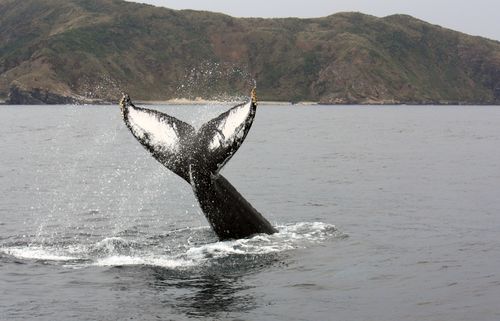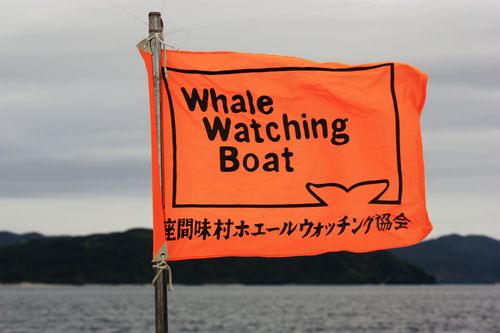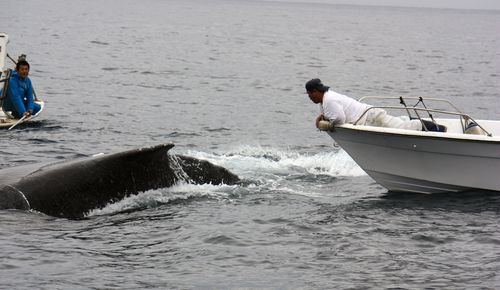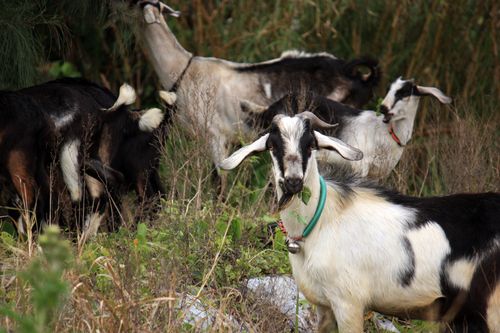CONTRIBUTED BY MICHELLE D.
Among the many marine activities you can experience in Okinawa, whale watching is probably one of the easiest and most rewarding. The start of the new year heralds the return of humpback whales (ザトウクジラ) to Okinawa, the Philippines, and Hawaii when these great mammals migrate south from the Arctic to mate and give birth to new calves in more temperate waters. Okinawa’s Kerama islands (慶良間諸島) — well known for their diving and snorkeling spots — is a picturesque location to view the whales close up as they swim in and out around the small islands.
Ecotourism, of course, doesn’t come cheap, and as an earlier Okinawa Hai post outlines, prepare to spend anywhere from $40-75 per adult for the trip. I’ll admit I was skeptical at first — since the price tag may seem steep for what is essentially a two hour boat ride. However, after biting the bullet and going out with the Zamami Whale Watching Association, I’d highly recommend this experience to anyone who hasn’t tried it yet.
The Experience: Whales are amazing animals, and it’s difficult to truly appreciate their immense size, beauty, and intelligence until you see them up close and personal. A good tour will achieve one goal — getting you out on the water near the whales. A great one will also help you understand more about the animals, how to spot them, and their history of coming to the waters near Okinawa.
Step One: Choosing your whale watching tour operator. Below I’ll outline some of the pros and cons for using the Zamami Whale Watching Association vs. the other readily-available options.
Okinawa whale watching tours depart both from Naha and from the Kerema islands — including ones arranged by various US military branches (check comments at bottom of post) or local Japanese tour operators. Although the first option might be the easiest, especially for people with no Japanese language ability, the Zamami Whale Watching Association (座間味村ホエールウォッチング協会) offers the opportunity to go out with local residents from Zamami (most of the boat captains also seem to work for dive shops on the island during the summer high tourist season), appreciate the warm hospitality of Zamami’s tourism-focused residents, and to know that your money is going toward supporting the local Zamami island community (instead of the USG or a Tokyo-operated tour company in Naha).
The Zamami Whale Watching Association (I’ll call it ZWWA) is based off of Zamami island and is a locally-operated group that consists of local boat captains, land-based tour organizers and administrators, and whale spotters located in the island’s observation platforms who use binoculars to scan the nearby seas for whale breaches. It’s a well-run production that includes a pre-departure introduction to the humpback whales (including images of tail markings identifying some of the individual whales who are frequently spotted in the area) and pamphlets in Japanese and English. They run two-hour morning and afternoon tours during which they have the capacity to accommodate up to 40 people on their fleet of small diving boats.
Of course, the main difference between the ZWWA and tours that depart from Naha is that you have to take a separate ferry over to Zamami Island (which requires additional cost and planning). From this angle, it may be difficult to justify choosing this local whale watching option… But I found that combining whale watching with an overnight stay on Zamami island was a very enjoyable way to see the whales, relax in a small Okinawan village, and simply get away from life’s worries for 24 hours.
Additionally, due to the island’s close proximity to whale watching locations, after leaving the port, it’s only a short hop on the small boats to reach the various spots frequented by whales around the Kerema islands. The boat captains are in radio and cell phone contact with each other as well as other ZWWA workers back on land, and they utilize this convergence of information as well as their familiarity with the waters to try to maximize whale spotting opportunities. The Association’s website provides trip reports at the end of every day, and it certainly looks like they have a solid history of locating the whales and bringing people close to them.
Note – If you tend to get seasick, taking the ferry over to Zamami island may be better than making the crossing over to the Kerema islands on a smaller charter boat (as the tours leaving from Naha do) because the trip is somewhat less rough on the larger ferry…
Step Two: The logistics. The island is most easily reached using the twice-daily “Queen Zamami” ferry that departs from Tomari Warf just north of Naha and takes 50-70 minutes to reach Zamami. The larger Ferry Zamami takes 90-120 minutes per trip and departs just once per day from Naha . This Okinawa Hai post provides all the pertinent details for using the ferry to get to Zamami, so I won’t rehash it here. One note though — During off-season, the boat doesn’t seem to fill anywhere near capacity, so it probably isn’t necessary to reserve tickets in advance. Just show up at the wharf with sufficient time to park, buy tickets from the counter, and walk down the boat, and you should be fine.
The ZWWA schedules its tours to accommodate people who are doing the activity as a daytrip, so the morning tour departs shortly after the Queen Zamami docks, and the afternoon tour is likewise timed to coincide with the arrival of the other daily boat, the Ferry Zamami.
Reservations with the ZWWA can be made via email in either English or Japanese — see their website for details. Be prepared to pay in cash at Zamami port before your tour begins. Because the island is so small, the logistics at Zamami Port are quite simple: Someone holding a bright orange sign will meet you as you disembark from the ferry, guide you inside the main port building, and show you where to pay for the tour. Then, once the group has assembled and received the whale introduction, you’ll be shown back out to the dock where the small diving boats are waiting. The port building itself has bathrooms and a gift shop — there are only a few small coin lockers , but the ZWWA has a spacious administrative area, and they will happily store any bags you don’t want to carry aboard the small boats.
Zamami Island is a small tourism-based community that offers mainly B&B or hostel style lodging. This website provides a good list of options — I’d recommend Nakayamaguwa for people looking for relatively inexpensive Japanese-style lodging and who don’t mind shared shower facilities (though in off season there are fewer guests and little competition for showers). The owner is kind and able to explain all about the area in English. All the lodging options are in a small walking radius of the port though, so all choices are probably equally convenient.
Once you have experienced the whale watching, off-season activities in Zamami include hiking up to the observation platforms (the nearest is a pleasant 2.5km climb), walking along the water to nearby beaches, or eating at one of several tasty local restaurants. You may encounter cute semi-feral cats, goat herds, and interesting local flora. The pace of life is leisurely, and the air smells crisp and fresh.
Details:
The Price: Roundtrip tickets on the Queen Zamami will cost you 5,230 yen. The same on the Ferry Zamami is 3,540 yen. Tickets for whale watching are 5,250 yen per adult and 2,625 yen per child. Lodging is anywhere from 3,000-7,000 per person per night. Bring enough yen to pay for all expenses, including meals, on Zamami Island in cash. If you need information on other costs (such as brining a car to Zamami, which I wouldn’t actually recommend), see this Japanese language page. Although the ferry time schedule on Zamami Island’s English language whale watching page (see link section at the end of this post) appears to be accurate, if you click on the “this month” link located in the top left of the Japanese page, you can see the latest information on schedule changes.
The weather: Overcast skies are actually nice for whale watching because you don’t bake in the sun, but be aware that neither the Queen Zamami nor the small ZWWA boats operate in rough weather. Staying overnight on Zamami increases the probability of avoiding missing out on whale watching due to weather cancellations — you could take the Saturday morning ferry over for a Saturday morning tour, but if you plan on leaving Sunday afternoon, you could also do the Saturday afternoon or Sunday morning tour if your first option is cancelled. The Ferry Zamami runs regardless of the weather, so you don’t have to worry about getting stranded on the island.
Food and Supplies: Despite being a small place, Zamami has several restaurants and a market that’s open from 0700-2300. Some lodging options also provide breakfast and/or dinner. If you go one the morning whale watching tour, keep in mind that most restaurants on the island seem to stop serving lunch by about 1430, so you may not want to linger too long looking over whale postcards and t-shirts at the gift shop after your trip is over.
Bottom Line: Staying overnight on Zamami after using the ZWWA offers a unique opportunity to experience small island life, explore the island when it’s not overrun with summer tourists, and take advantage of the local Association’s familiarity with the whales and the local environment. It is a more expensive and more complicated alternative to using a USG or Naha-based whale watching tour, but it’s certainly a fun weekend activity that adds more depth to the whale watching experience and can provide a refreshing taste of small town Okinawa.
Upcoming Events: whale watching season runs from January until April (although it’s said that February is the best month). Zamami will host its 2011 Whale Watching Fiesta on 21 March.
Additional Information:
Zamami Whale Watching Association website
Whale Watching Association English-language page
2 May 2010 Japan Times article on Zamami’s slow island lifestyle
14 Feb 2001 Japan Times article that mentions Zamami’s Whale Watching Society
23 January 2009 Japan Update post on whale watching in Okinawa
For more information, check out this English travel guide to Zamami Village, Okinawa.







http://www.vill.zamami.okinawa.jp/whale/english.html
Found this if anyone needs it!
Found this if anyone needs it!
Thanks for the link to Zamami English Guide! I saw a small spike in traffic yesterday due to your article. I need to figure out how to get more exposure on this site since a decent percentage of foreign visitors to Zamami are military.
–David